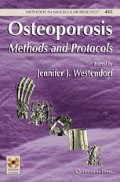Abstract
In vivo assessment of bone formation (osteogenesis) potential by isolated cells is an important method for analysis of cells and factors control ling bone formation. Currently, cell implantation mixed with hydroxyapa-tite/tricalcium phosphate in an open system (subcutaneous implantation) in immunodeficient mice is the standard method for in vivo assessment of bone formation capacity of a particular cell type. The method is easy to perform and provides reproducible results. Assessment of the donor origin of tissue formation is possible, especially in the case of human-to-mouse transplanta tion, by employing human specific antibodies or in situ hybridization using human specific Alu-repeat probes. Recently, several methods have been developed to quantitate the newly formed bone using histomorphometric methods or using non-invasive imaging methods. This chapter describes the use of in vivo transplantation methods in testing bone formationpotential of human mesenchymal stem cells.
Access this chapter
Tax calculation will be finalised at checkout
Purchases are for personal use only
References
1. Abdallah, B. M., Haack-Sorensen, M., Burns, J. S., et al. (2005) Maintenance of differentia tion potential of human bone marrow mesenchymal stem cells immortalized by human telom-erase reverse transcriptase gene in despite of extensive proliferation. Biochem Biophys Res Commun 326, 527–538.
2. Kuznetsov, S. A., Krebsbach, P. H., Satomura, K., et al. (1997) Single-colony derived strains of human marrow stromal fibroblasts form bone after transplantation in vivo.J Bone Miner Res 12, 1335–1347.
3. Bab, I., Ashton, B. A., Gazit, D., et al. (1986) Kinetics and differentiation of marrow stromal cells in diffusion chambers in vivo. J Cell Sci 84, 139–151.
4. Krebsbach, P. H., Kuznetsov, S. A., Satomura, K., et al. (1997) Bone formation in vivo: com parison of osteogenesis by transplanted mouse and human marrow stromal fibroblasts. Transplantation 63, 1059–1069.
5. Kratchmarova, I., Blagoev, B., Haack-Sorensen, M., et al. (2005) Mechanism of divergent growth factor effects in mesenchymal stem cell differentiation. Science 308, 1472–1477.
6. Shultz, L. D., Schweitzer, P. A., Christianson, S. W., et al. (1995) Multiple defects in innate and adaptive immunologic function in NOD/LtSz-scid mice. J Immunol 154, 180–191.
7. Fisher, L. W., Robey, P. G., Tuross, N., et al. (1987) The Mr 24,000 phosphoprotein from developing bone is the NH2-terminal propeptide of the alpha 1 chain of type I collagen. J Biol Chem 262, 13457–13463.
8. Fisher, L. W., Hawkins, G. R., Tuross, N., et al. (1987) Purification and partial characteriza tion of small proteoglycans I and II, bone sialoproteins I and II, and osteonectin from the mineral compartment of developing human bone. J Biol Chem 262, 9702–9708.
9. Kassem, M., Mosekilde, L., Eriksen, E. F. (1993) 1,25-dihydroxyvitamin D3 potentiates fluo ride-stimulated collagen type I production in cultures of human bone marrow stromal osteob-last-like cells. J Bone Miner Res 8, 1453–1458.
10. Simonsen, J. L., Rosada, C., Serakinci, N., et al. (2002) Telomerase expression extends the proliferative life-span and maintains the osteogenic potential of human bone marrow stromal cells. Nat Biotechnol 20, 592–596.
11. Stenderup, K., Rosada, C., Justesen, J., et al. (2004) Aged human bone marrow stromal cells maintaining bone forming capacity in vivo evaluated using an improved method of visualiza tion. Biogerontology 5, 107–118.
12. Bruder, S. P., Kurth, A. A., Shea, M., et al. (1998) Bone regeneration by implantation of puri fied, culture-expanded human mesenchymal stem cells. J Orthop Res 16, 155–162.
13. Kuznetsov, S. A., Mankani, M. H., Robey, P. G. (2000) Effect of serum on human bone marrow stromal cells: ex vivo expansion and in vivo bone formation. Transplantation 70, 1780–1787.
14. Mankani, M. H., Krebsbach, P. H., Satomura, K., et al. (2001) Pedicled bone flap formation using transplanted bone marrow stromal cells. Arch Surg 136, 263–270.
15. Hatano, H., Tokunaga, K., Ogose, A., et al. (1998) Origin of bone-forming cells in human osteosarcomas transplanted into nude mice—which cells produce bone, human or mouse? J Pathol 185, 204–211.
16. Dennis, J. E., Konstantakos, E. K., Arm, D., et al. (1998) In vivo osteogenesis assay: a rapid method for quantitative analysis. Biomaterials 19, 1323–1328.
17. Kaigler, D., Wang, Z., Horger, K., et al. (2006) VEGF scaffolds enhance angiogenesis and bone regeneration in irradiated osseous defects. J Bone Miner Res21, 735–744.
18. Gundersen, H. J., Bendtsen, T. F., Korbo, L., et al. (1988) Some new, simple and efficient stereological methods and their use in pathological research and diagnosis. APMIS 96, 379–394.
19. Kerndrup, G., Pallesen, G., Melsen, F., et al. (1980) Histomorphometrical determination of bone marrow cellularity in iliac crest biopsies. Scand J Haematol 24, 110–114.
Author information
Authors and Affiliations
Editor information
Editors and Affiliations
Rights and permissions
Copyright information
© 2008 Humana Press, a part of Springer Science+Business Media, LLC
About this protocol
Cite this protocol
Abdallah, B.M., Ditzel, N., Kassem, M. (2008). Assessment of Bone Formation Capacity Using In vivo Transplantation Assays: Procedure and Tissue Analysis. In: Westendorf, J.J. (eds) Osteoporosis. Methods In Molecular Biology™, vol 455. Humana Press. https://doi.org/10.1007/978-1-59745-104-8_6
Download citation
DOI: https://doi.org/10.1007/978-1-59745-104-8_6
Publisher Name: Humana Press
Print ISBN: 978-1-58829-828-7
Online ISBN: 978-1-59745-104-8
eBook Packages: Springer Protocols

